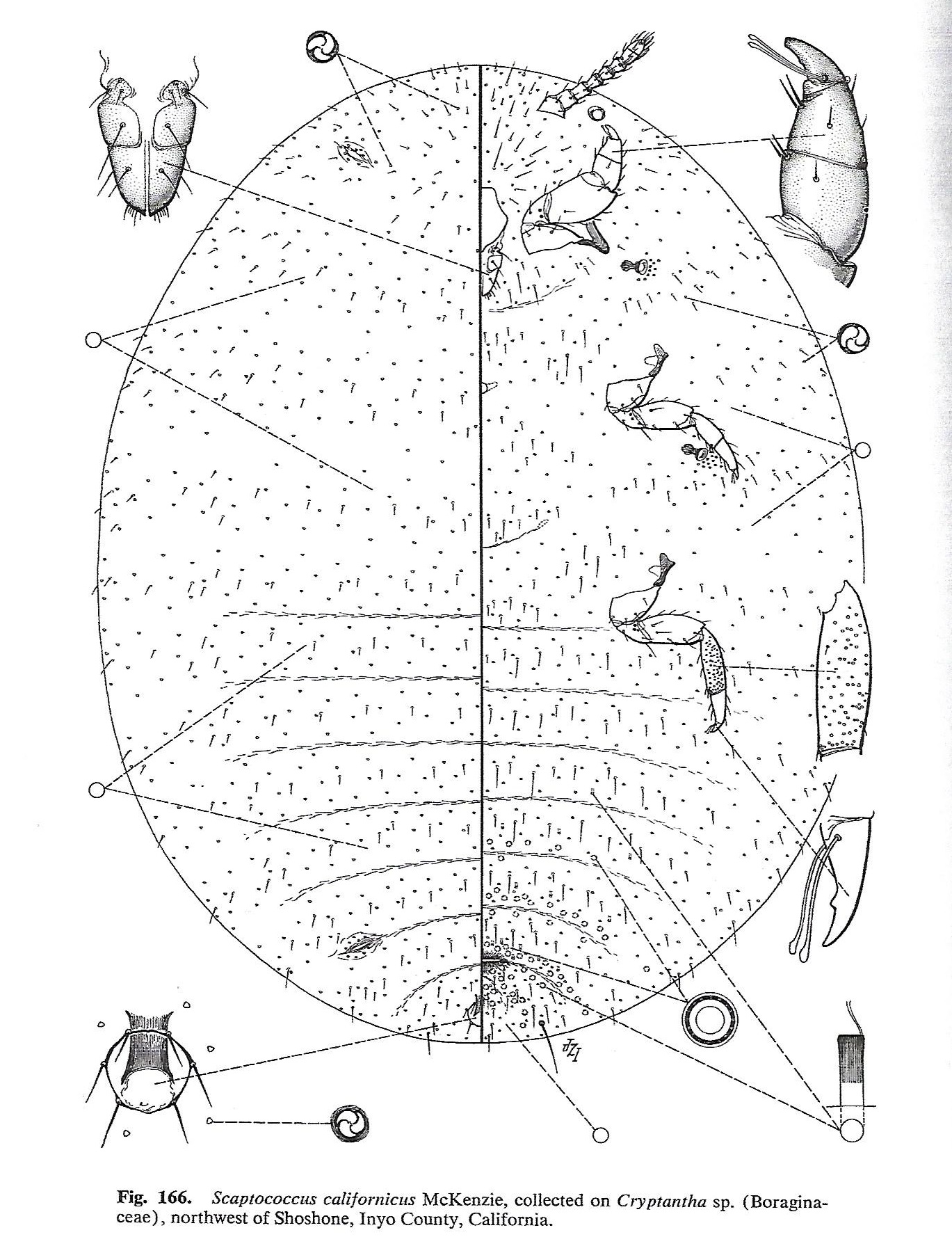Valid Names Results
Scaptococcus californicus McKenzie, 1964 (Pseudococcidae: Scaptococcus)Nomenclatural History
- Scaptococcus californicus McKenzie 1964: 267. Type data: U.S.A.: California, Inyo County, near Shoshone, on Cryptantha sp.. Holotype, female, Type depository: Davis: The Bohart Museum of Entomology, University of California, California, USA; accepted valid name Notes: Paratypes (13 adults, 1 immature), same data as holotype [BME]; 4 adult ♀♀ paratypes, same data as holotype [CSCA]. Illustr.
Common Names
- digger mealybug McKenz1967
- Digger mealybug McKenz1967
Ecological Associates
Hosts:
Families: 4 | Genera: 7
- Asteraceae
- Malacothrix | VonEllWa2019
- Boraginaceae
- Amsinckia | BenDov1994 McKenz1967
- Cryptantha | BenDov1994 McKenz1964
- Pectocarya platycarpa | VonEllWa2019
- Brassicaceae
- Caulanthus inflatus | VonEllWa2019
- Lepidium thurberi | VonEllWa2019
- Fabaceae
- Calliandra eriophylla | VonEllWa2019
Geographic Distribution
Countries: 1
- United States
- Arizona | VonEllWa2019
- California | BenDov1994 McKenz1964
Keys
- VonEllWa2019: pp.399 ( Adult (F) ) [Species of Scaptococcus]
- McKenz1967: pp.406 ( Adult (F) ) [U.S.A., California]
Remarks
- Systematics: The adult female of S. californicus can be separated from other Scaptococcus species by the lack of a circulus; having modified oral collar tubular ducts, multilocular pores and, when present, quinquelocular pores restricted to the venter; and having an anal ring without cellular pores. The anal ring lacking cellular pores and absence of a circulus enables separation of female nymphs of S. californicus from those of the other two known Scaptococcus species, both of which have circuli and at least some cellular pores in the anal ring. (von Ellenrieder & Watson, 2019)
- Structure: Usually the antennae are 8-segmented, but are quite frequently 9-segmented (in the holotype, two paratypes and 15 additional specimens) or, rarely, 7-segmented. Several specimens possess a few quinquelocular pores on the venter of SV–VIII, interspersed among the multilocular pores.(von Ellenrieder & Watson, 2019) First-instar nymph. Antenna 6-segmented; it shares with the adult female the presence of anterior andposterior ostioles, a plantar denticle on the claw, trilocular pores and setae flagellate and slender on dorsum and venter, absence of a circulus, and a simplified anal ring lacking cellular pores. Besides lacking a vulva, it differs from the adult female by lacking multilocular and quinquelocular pores. Modified oral collar tubular ducts were not detected. Ellenrieder & Watson, 2019)
- Biology: Scaptococcus californicus occurs in sand dunes on the crown and roots of its hosts; adult females are each enclosed in a cyst-like, waxy ovisac, surrounded by loose particles of moist soil that also contains nymphs (McKenzie 1967).
- General Remarks: Description and illustration of the adult female given by McKenzie (1964, 1967). Amended inn von Ellenrieder & Watson, 2019.
Illustrations
Citations
- BenDov1994: catalog, 480
- McKenz1964: description, distribution, host, illustration, taxonomy, 267-269
- McKenz1967: description, distribution, host, illustration, taxonomy, 407-408
- VonEll2025: distribution, 34
- VonEllWa2019: biology, description, description of male, diagnosis, distribution, host, key, nymph, 388



